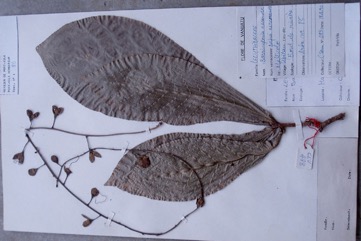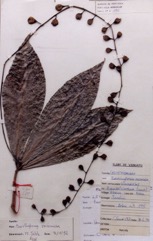Fish Poison Tree

A tropical plant. It prefers well-drained, moist, humus rich soil. It can grow in a sheltered, partly shaded position. It is drought tender and very frost tender. Found throughout the Philippines in areas of shrub near the seashore and open lowlands up to 320 m altitude. It grows in coastal swamps and along stream banks. It can resist strong sea breezes. It is salt tolerant. It can grow in arid places. It suits hardiness zones 10-12.
Also known as:
Butun darat, Cassowary pine, Foto-be, Freshwater mangrove, Ijjal, Jik, Kaiengal, Kyi-byu, Mango Pine, Massinhava, Midhilijan, Mtoko, Mutovatova, Paopao, Pneggung, Poeierkwasboom, Pohon putat sungai, Powder-puff tree, Putat darat, Putat kamp, Putat kampung, Putat kedul, Putat sungai, Rfungue, Samudraphala, Taung-kyi
Synonyms
- Barringtonia apiculata (Miers) R. Knuth [Illegitimate]
- Barringtonia caffra (Miers) E. Mey. ex R. Knuth
- Barringtonia caffra E. Mey.
- Barringtonia celebesensis R. Knuth
- Barringtonia ceramensis R. Knuth
- Barringtonia ceylanica (Miers) Gardner ex C. B. Clarke
- Barringtonia elongata Korth.
- Barringtonia excelsa A. Gray
- Barringtonia inclyta Miers Ex B. D. Jacks. [Invalid]
- Barringtonia lageniformis Merr. & L. M. Perry
- Barringtonia longiracemosa C. T. White
- Barringtonia obtusangula R. Knuth
- Barringtonia pallida Koord. & Valeton
- Barringtonia racemosa Oliv.
- Barringtonia racemosa var. elongata (Korth.) Blume
- Barringtonia racemosa var. minor Blume
- Barringtonia racemosa var. procera Blume
- Barringtonia racemosa var. subcuneata Miq.
- Barringtonia rosaria Oken
- Barringtonia rosata (Sonn.) R. Knuth
- Barringtonia rumphiana (Miers) R. Knuth
- Barringtonia salomonensis Rech.
- Barringtonia stravadium Blanco
- Barringtonia terrestris (Miers) R. Knuth
- Barringtonia timorensis Blume
- Butonica alba (Pers.) Miers [Illegitimate]
- Butonica apiculata Miers
- Butonica caffra Miers
- Butonica ceylanica Miers
- Butonica inclyta Miers
- Butonica racemosa (L.) Juss.
- Butonica rosata (Sonn.) Miers
- Butonica rumphiana Miers
- Butonica terrestris Miers
- Caryophyllus racemosus (L.) Stokes
- Eugenia racemosa L.
- Huttum racemosum (L.) Britten
- Megadendron ambiguum Miers
- Megadendron pallidum Miers
- Menichea rosata Sonn.
- Michelia apiculata (Miers) Kuntze
- Michelia ceylanica (Miers) Kuntze
- Michelia racemosa (L.) Kuntze
- Michelia rosata (Sonn.) Kuntze
- Michelia timorensis (Blume) Kuntze
- Stravadium album Pers. [Illegitimate]
- Stravadium obtusangulum Blume
- Stravadium racemosum (L.) Sweet
- Stravadium racemosa (L.) Miers
- Stravadium rubrum DC. [Illegitimate]
Edible Portion
- Leaves, Fruit, Seeds, Caution
Where does Fish Poison Tree grow?
Found in: Africa, Andamans, Asia, Australia, Bangladesh, Carolines, China, Christmas Island, Chuuk, Comoros, East Africa, East Timor, Fiji, FSM, Guam, Hawaii, India, Indochina, Indonesia, Japan, Kenya, Laos, Madagascar, Malaysia, Maldives, Marquesas, Micronesia, Mozambique, Myanmar, New Caledonia, Pacific, Palau, Papua New Guinea, PNG, Philippines, Rotuma, Samoa, SE Asia, Seychelles, Singapore, Solomon Islands, Somalia, South Africa, Southern Africa, Sri Lanka, Taiwan, Tanzania, Thailand, Timor-Leste, Vanuatu, Yap
Notes: Many parts of the plant are used to stun fish. There are about 40 Barringtonia species. It possibly has anti-cancer properties.
Status: It is not known if it is used for food in Papua New Guinea.
Growing Fish Poison Tree
Cultivation: Plants are grown from seed. Seed need to be sown fresh. It can be grown from cuttings.
Edible Uses: The seeds and young leaves are eaten. The seeds are pounded and starch extracted. The leaves are cooked and eaten as a vegetable. They are first soaked in lime water. Caution: The fruit are used to poison wild pigs.
Production: Trees grow easily and rapidly.
Nutrition Info
per 100g edible portion| Edible Part | Energy (kcal) | Protein (g) | Iron (mg) | Vitamin A (ug) | Vitamin c (mg) | Zinc (mg) | % Water |
|---|---|---|---|---|---|---|---|
| Leaves | - | - | - | - | - | - | |
| Seeds - starch | - | - | - | - | - | - |
Fish Poison Tree Photos


References
Ambasta S.P. (Ed.), 2000, The Useful Plants of India. CSIR India. p 68
Arora, R. K., 2014, Diversity in Underutilized Plant Species - An Asia-Pacific Perspective. Bioversity International. p 90
Barwick, M., 2004, Tropical and Subtropical Trees. A Worldwide Encyclopedic Guide. Thames and Hudson p 45
Bircher, A. G. & Bircher, W. H., 2000, Encyclopedia of Fruit Trees and Edible Flowering Plants in Egypt and the Subtropics. AUC Press. p 54
Bodkin, F., 1991, Encyclopedia Botanica. Cornstalk publishing, p 133
Bole, P.V., & Yaghani, Y., 1985, Field Guide to the Common Trees of India. OUP p 19
Burkill, I.H., 1966, A Dictionary of the Economic Products of the Malay Peninsula. Ministry of Agriculture and Cooperatives, Kuala Lumpur, Malaysia. Vol 1 (A-H) p 308
Cooper, W. and Cooper, W., 2004, Fruits of the Australian Tropical Rainforest. Nokomis Editions, Victoria, Australia. p 266
Cowie, I, 2006, A Survey of Flora and vegetation of the proposed Jaco-Tutuala-Lore National Park. Timor-Lests (East Timor) www.territorystories.nt/gov.au p 49
Cribb, A.B. & J.W., 1976, Wild Food in Australia, Fontana. p 74
Cundall, P., (ed.), 2004, Gardening Australia: flora: the gardener's bible. ABC Books. p 220
Dobriyal, M. J. R. & Dobriyal, R., 2014, Non Wood Forest Produce an Option for Ethnic Food and Nutritional Security in India. Int. J. of Usuf. Mngt. 15(1):17-37
Elliot, W.R., & Jones, D.L., 1982, Encyclopedia of Australian Plants suitable for cultivation. Vol 2. Lothian. p 307
Etherington, K., & Imwold, D., (Eds), 2001, Botanica's Trees & Shrubs. The illustrated A-Z of over 8500 trees and shrubs. Random House, Australia. p 119
Flora of Australia, Volume 8, Lecythidales to Batales, Australian Government Publishing Service, Canberra (1982) p 5
Franklin, J., Keppel, G., & Whistler, W., 2008, The vegetation and flora of Lakeba, Nayau and Aiwa Islands, Central Lau Group, Fiji. Micronesica 40(1/2): 169–225, 2008
Hinton, B & B., 1982, A Wilderness in Bloom. Wildflowers of tropical Australia. p 51
Jones D, L, 1986, Ornamental Rainforest Plants in Australia, Reed Books, p 198
Kaume, R.N., 2005. Barringtonia racemosa (L.) Spreng. [Internet] Record from Protabase. Jansen, P.C.M. & Cardon, D. (Editors). PROTA (Plant Resources of Tropical Africa / Ressources végétales de l’Afrique tropicale), Wageningen, Netherlands. < http://database.prota.org/search.htm>. Accessed 14 October 2009.
Lazarides, M. & Hince, B., 1993, Handbook of Economic Plants of Australia, CSIRO. p 31
Lebot, V. & Sam, C., Green desert or ‘all you can eat’? How diverse and edible was the flora of Vanuatu before human introductions?. Terra australis 52 p 410
Llamas, K.A., 2003, Tropical Flowering Plants. Timber Press. p 244
Lovelock, C., & Clarke, S., 1999, Field Guide to the Mangroves of Queensland. Australian Institute of Marine Science. p 44
Martin, F.W. & Ruberte, R.M., 1979, Edible Leaves of the Tropics. Antillian College Press, Mayaguez, Puerto Rico. p 197
Menninger, E.A., 1977, Edible Nuts of the World. Horticultural Books. Florida p 38
Monsalud, M.R., Tongacan, A.L., Lopez, F.R., & Lagrimas, M.Q., 1966, Edible Wild Plants in Philippine Forests. Philippine Journal of Science. p 485
Morley, B.D., & Toelken, H.R., (Eds), 1983, Flowering Plants in Australia. Rigby. p 174
Murakami, A. et al, 2014, Screening for the In Vitro Anti-tumor-promoting Activities of Edible Plants from Malaysia. Bioscience, Biotechnology, and Biochemistry, 64:1, 9-16.
Nurfadilah, S., et al, 2017, Species richness, conservation status, and potential uses of plants in Segara Anakan Area of Sempu Island, East Java, Indonesia. BIODIVERSITAS. Volume 18, Number 4
Palgrave, K.C., 1996, Trees of Southern Africa. Struik Publishers. p 652
Palmer, E and Pitman, N., 1972, Trees of Southern Africa. Vol. 3. A.A. Balkema, Cape Town p 1597
Peekel, P.G., 1984, (Translation E.E.Henty), Flora of the Bismarck Archipelago for Naturalists, Division of Botany, Lae, PNG. p 397, 396
Prance, G. T. & Jongkind, C. H., 2015, A Revision of African Lecythidaceae. Kew Bulletin. 70:1-68
Roth, W.E., 1901,
Royal Botanic Gardens, Kew (1999). Survey of Economic Plants for Arid and Semi-Arid Lands (SEPASAL) database. Published on the Internet; http://www.rbgkew.org.uk/ceb/sepasal/internet [Accessed 21st April 2011]
Samy, J., Sugumaran, M., Lee, K. L. W., 2009, Herbs of Malaysia, Marshall Cavendish. p 61
Scarth-Johnson, V., 2000, National Treasures. Flowering Plants of Cooktown and Northern Australia. Vera Scarth-Johnson Gallery Association. Cooktown, Australia. p 35
Schatz, G.E., 2001, Generic Tree Flora of Madagascar. Royal Botanical Gardens, Kew and Missouri Botanical Garden. p 230
Smith, A.C., 1981, Flora Vitiensis Nova: A New flora of Fiji, Hawai Botanical Gardens, USA Vol 2 p 495
Somnasang, P., Moreno, G and Chusil K., 1998, Indigenous knowledge of wild hunting and gathering in north-east Thailand. Food and Nutrition Bulletin 19(4) p 359f
Specht, R.L., 1958,
Sujanapal, P., & Sankaran, K. V., 2016, Common Plants of Maldives. FAO & Kerala FRI, p 51
Sukarya, D. G., (Ed.) 2013, 3,500 Plant Species of the Botanic Gardens of Indonesia. LIPI p 149
Townsend, K., 1994, Across the Top. Gardening with Australian Plants in the tropics. Society for Growing Australian Plants, Townsville Branch Inc. p 98
van Wyk, B, van Wyk, P, and van Wyk B., 2000, Photographic guide to Trees of Southern Africa. Briza. p 61
World Checklist of Useful Plant Species 2020. Royal Botanic Gardens, Kew
www.worldagroforestrycentre.org/treedb/
Zawiah, N. & Othaman, H., 2012, 99 Spesies Buah di FRIM. Institut Penyelidikan Perhutanan Malaysia. p 68